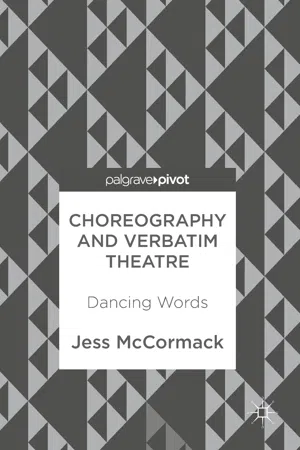To Translate into Dance?
If choreographing responses to verbatim recorded/spoken language can be viewed as a form of intermedial translation, from verbal spoken language to body or corporeal text, then how can this influence approaches to verbatim dance-theatre? The term and concept of translation, which has been central to the development of Western Dance-Theatre has taken on a new and more specific significance in the practice of verbatim/documentary dance. As discussed in the Introduction, the development of new and non-classical forms of dance in Europe began in the late 1920s with the emergence of Ausdruckstanz. Practitioners such as Mary Wigman, Kurt Jooss and Rudolph Laban all experimented with forms of expressive dance alongside the development of non-naturalistic forms of theatre, modernist art and music (Partsch-Bergsohn and Bergsohn 2003). Influenced by these earlier practitioners’ rejection of the uniformity of classical movement, practitioners in 1970s Europe, such as Pina Bausch and Anne Teresa de Keersmaeker, further developed the form of dance-theatre (or Tanztheater) and explored the possibility of creating meaning and self-expression within dance. The Tanztheater movement began to break down boundaries between different art forms, with a focus on multiplicity and ambiguity, by combining and layering fragments of spoken text, movement, objects and images. This breaking down of boundaries and transition between different media introduced the concept of ideas being moved/translated from one medium to another. However, there was rarely one starting point within this work and the elements were developed organically alongside each other. For example, Bausch rarely based her work on existing text. She describes how a piece develops from her self-expression, stating that the work is ‘growing within [her]’ (Servos 2008: 237). In the 1980s and 1990s, companies such as DV8 Physical Theatre, Ultimavez, Volcano Theatre Company and VTOL Dance Company continued to break down the barriers between different art forms and explored the combination of language and movement in live performance. These companies began to experiment by taking source material, such as interviews (DV8 Physical Theatre, MSM, 1993), short stories (Ultimavez, Mountains Made of Barking, 1994) or Shakespeare’s sonnets (Volcano Theatre Company, L.O.V.E, 1993), and developing choreographic processes to translate these texts into movement. These companies also became well known for confronting physicality and choreography, with a focus on taking risks (Murray and Keefe 2007). Dance-theatre and physical theatre practitioners and companies working in the UK and Europe today, including DV8 Physical Theatre, Jasmin Vardimon, Ballet C de la B, DOT 504, Fabulous Beast, Bodies in Flight, Ultimavez, Frantic Assembly and Probe, have all investigated the integration of text and choreography and have developed improvisational and devising techniques with this integration as the focus. As a result of working with, or in-between, different art forms, the term and concept of ‘translation’, defined as the shift between one form and another, has become central to choreographic discourse. The use of the concept ‘translation’ can be found in choreographers’ commentary on their choreographic process. Before making a rigorous analysis of the term and concept of translation from the point of view of translation studies, I will briefly consider the term as it occurs in choreographic discourse. Commentary on the choreographic process by choreographers sees the term used to describe the choreographic process of transferring ideas/language/images into a physical language. In the examples below, dance-theatre practitioners use the term translation to describe creating choreographed movement as a response to a range of ideas, emotions, concepts, written/spoken language.
Pina Bausch, referring to how her choreographic process was enriched through making work for different cities in different countries with Tanztheater Wuppertal, including, Budapest, Palermo, Istanbul and London, uses the term ‘translated’ to name the process of turning this new experience into movement possibilities.
Getting to know completely foreign customs, types of music, habits has led to things that are unknown to us, but which still belong to us, all being translated into dance (Bausch 2007: 14).
Jasmin Vardimon, when interviewed about her
choreography for
Lullaby (2003), uses the term ‘translated’ to explain how the language and vocabulary of her subject matter, illness, was transferred to create the
movement vocabulary and dynamics of the
choreography.
Your choreography is quite physical and sometimes violent, do you try to shock your audience? (ZB)
No I just think that we are living in a quite violent world, unfortunately. I think it is a reality and I try to show that reality. The language which we use to talk about illness is a language of war, we talk about bacteria attacking our body, and the fight against it. Chemical warfare, x-rays—all the language is like warfare, so this is how I translated it to the movement, to the physicality. (Vardimon 2003, in Boden 2003)
An interview with the performers of Justitia (2007), published on the Jasmin Vardimon Company’s website, uses the term ‘translate’ to ask one performer how the company found ways to use movement to communicate the emotional journey undertaken by characters in the piece. ‘How do you translate these emotions into movement?’ (Jasmin Vardimon Company 2007).
Promotional material for Rosie Kay’s
Supernova (
2008) uses the term ‘translate’ to describe the move from scientific subject matter and concepts to
movement and the dancers are framed as translators.
Taking inspiration from time, space, energy and matter, Rosie Kay translates huge cosmic ideas into the physical, the personal and the emotional. Supernova is a journey of five extraordinary female dancers who translate the macro into the micro sensations inside us all. (Rosie Kay Dance Company 2011)
Promotional material for Les Ballets C de la B’s
Lisi Estaras’ primero (
2010) uses ‘translate’ to explain the transformation from an idea surrounding a psychological state of mind into
movement.
This intimate work mixes dance and text as the personal experiences of five performers are interweaved with children’s stories. Intrigued by the way a child’s mind can naturally jump from one thought to another, unpredictable and s...
